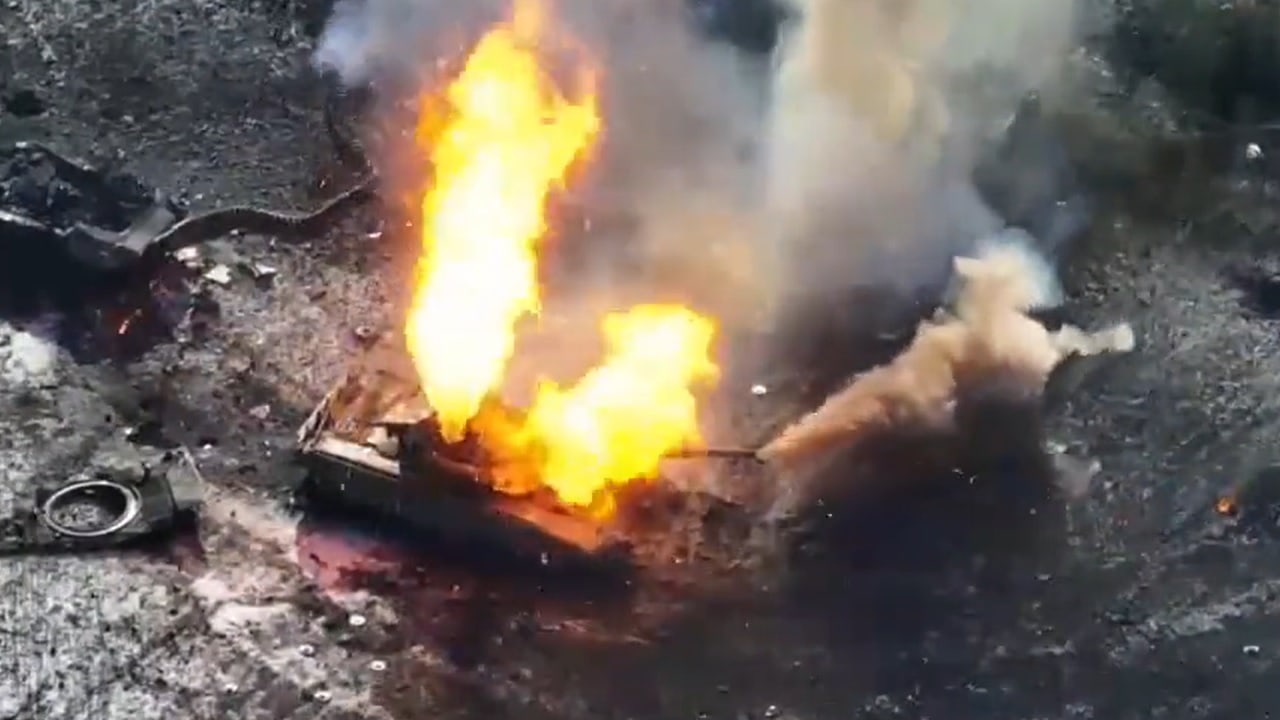Units of the Ukrainian 26th Artillery Brigade captured the destruction of a pair of Russian tanks and posted the short video clip to social media this past weekend.
The action had reportedly occurred earlier last week – and the two T-72/T-80 series tanks were targeted by U.S.-made HIMARS, while a Ukrainian Leleka-100 unmanned aerial vehicle was used for the observation.
The 26th Artillery Brigade, which is based in the historic city of Berdychiv, can trace its origins back to the Soviet Red Army’s 117th Guards Rifle Division, which was formed during the Second World War. Following the dissolution of the Soviet Union, it became the 62nd Mechanized Brigade, which, in turn, led to the formation of the 26th Artillery Brigade.
The unit currently operates a number of Western-supplied platforms including Panzerhaubitze 2000 (PzH 2000) 155mm self-propelled howitzers (SPHs) provided by Germany and Netherlands, as well as the aforementioned Lockheed Martin-produced HIMARs. The 26th Artillery Brigade has been active in the ongoing Battle of Bakhmut, which has evoked comparisons to the Second World War’s Battle of Stalingrad.
This Stork Delivers
Crucial to the success of the 26th Artillery Brigade is reported to be the Leleka-100, a drone developed by DEVIRO, a UAV company based in Ukraine specifically for air reconnaissance. The fixed-wing UAV with a V-tail configuration is made of Kevlar and carbon fiber. It has been in service since 2021. Known also as the “Stork,” the small unmanned aerial system (UAS) has also served as the basis for the RAM II loitering munition.
Even before Russia launched its unprovoked and wholly unwarranted invasion of Ukraine in February 2022, the Leleka-100 was employed to conduct border exploration and surveillance training. The key benefit of the system is that it is small enough that it can be carried in a backpack and launched from any open field with a bungee start while it can make a belly landing, or be returned to the ground with a parachute. It has an endurance of between 1.5 and 3.5 hours. Moreover, the Leleka-100 is powered by a quiet and reliable all-electric propulsion system, which allows for surveillance operations at low altitudes without being detected. It can reportedly operate in winds up to 20 m/s.
The fully autonomous Stork is equipped with inertial navigation, which allows operations to be carried out in severe conditions and without the use of GPS. It can carry electro-optical, thermal/daylight, and high-resolution imaging payloads including a PLCI Z30 daylight module with changeable 20x optical zoom, and a PLCI IR night vision module with fixed 4x optical zoom. Even in harsh weather situations, it can provide continuous intelligence, surveillance, and reconnaissance (ISR) in day or night operations.
As noted, the RAM II UAV loitering munition is based on the Stork – but it can deliver a 3kg (6.6 pound) explosive warhead to the target. The ordnance can include thermobaric, designed for hitting the inside of buildings and small armored vehicles with people; high-explosive anti-tank (HEAT) to hit heavily protected targets on land or at sea; and high-explosive fragmentation (HE-FRAG), a warhead designed to hit open space with live personnel targets.
Two tanks destroyed by the 26th brigade ????????
Cc @Teoyaomiquu pic.twitter.com/L42EFORhwo
— NOËL ???????? ???????? (@NOELreports) April 16, 2023
These drones can be the eyes in the sky, and the weapons to take out Russian targets.
Author Experience and Expertise: A Senior Editor for 19FortyFive, Peter Suciu is a Michigan-based writer. He has contributed to more than four dozen magazines, newspapers, and websites with over 3,200 published pieces over a twenty-year career in journalism. He regularly writes about military hardware, firearms history, cybersecurity, politics, and international affairs. Peter is also a Contributing Writer for Forbes and Clearance Jobs. You can follow him on Twitter: @PeterSuciu.

